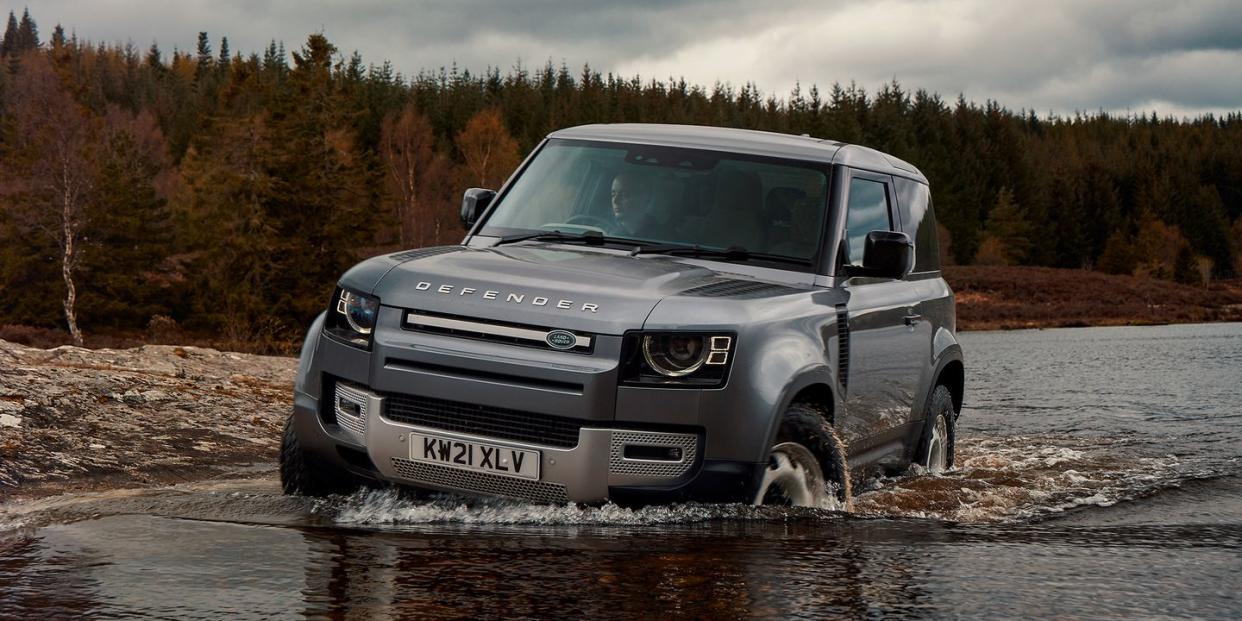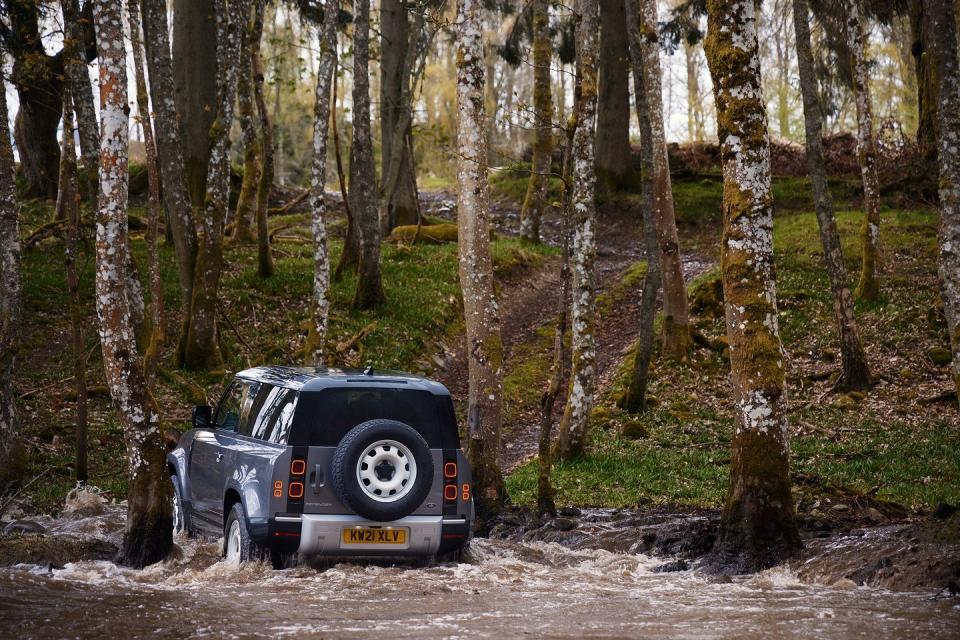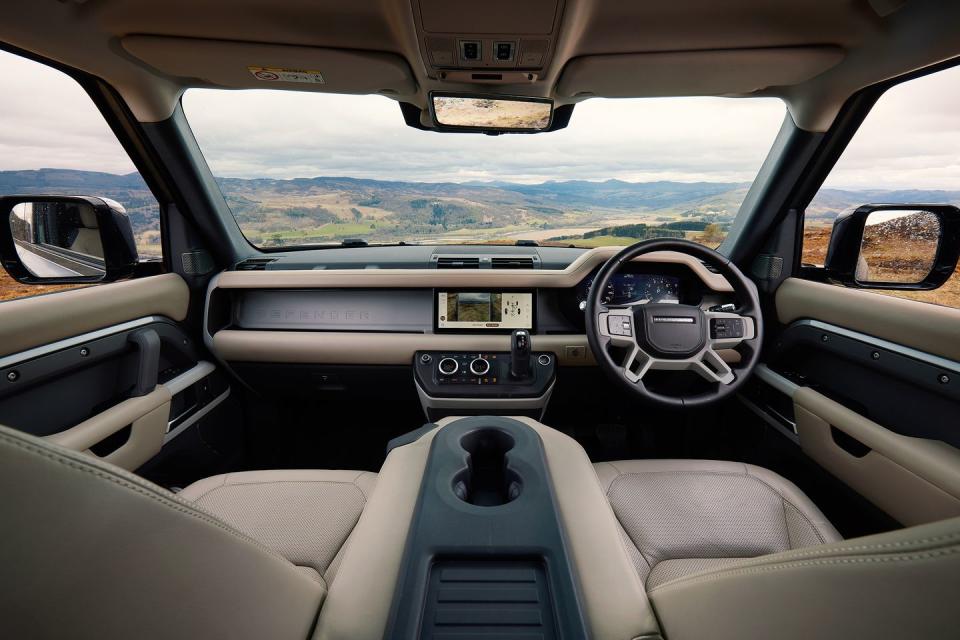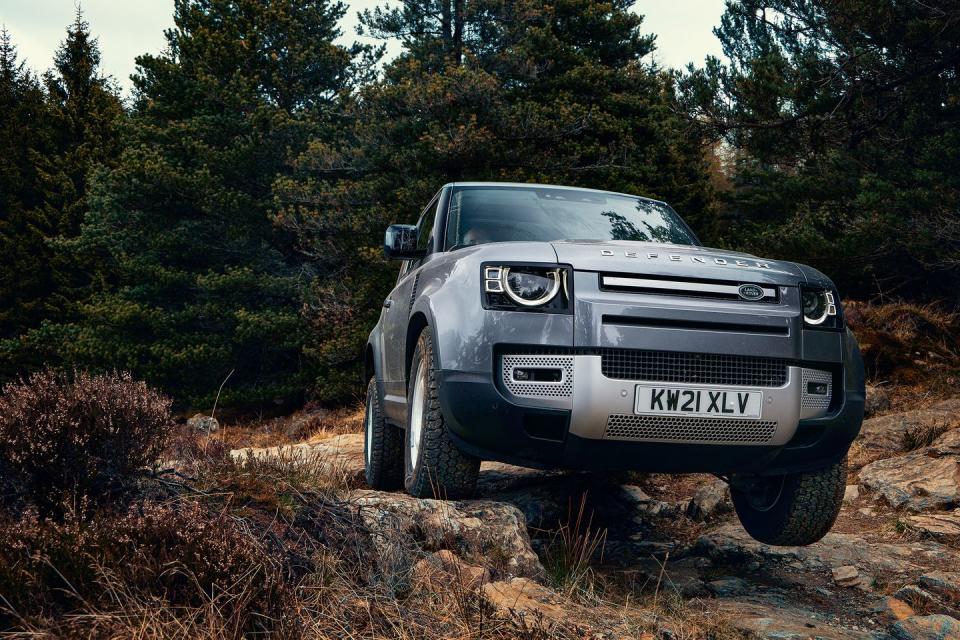2021 Land Rover Defender 90 Channels the Defender's Roots

From the June 2021 issue of Car and Driver.
British adventures are rarely spontaneous. This is a society that likes to prepare, with the intrepid among them bringing packages of sandwiches and insulated flasks of hot, milky tea—plus Arctic-spec clothing—when tackling the limited wilderness available on their densely populated small island.
That careful approach to the outdoors carries into the off-roading scene in the U.K., which lacks dunes and deserts that can be attacked at high speeds. With a tradition of vehicles like early Land Rovers that needed two-speed transfer cases to multiply the meager torque of their weedy engines, the Brits arrived at a gentle form of all-terrain driving prioritizing slow, steady progress rather than the adrenalized excitement of screaming engines and roostertails of dirt. The result is a tranquil experience.

We found that feeling on an excursion with a 2021 Land Rover Defender 90 in a remote and spectacularly beautiful corner of the Scottish Highlands. Land Rover's connection to this region goes back to the brand's origins. The Land Rover name was coined in 1947 during testing of a modified Rover 12 on a Highlands estate owned by Rover Car Company managing director Spencer Wilks. His Laggan Estate also served as a proving ground throughout the late '40s as the automaker developed a four-wheel-drive vehicle to compete with the war-surplus Jeeps that many British farmers were using. That vehicle eventually evolved into the Defender.
Nearly 75 years on, the new Defender 90 is very different from the original Land Rover, but with a clear design connection to the past. We brought it to the Highlands for a jaunt across a bigger, more demanding estate than Wilks's. This one belongs to the Duke of Atholl, who—fun fact—has the right to raise a private army, a privilege Queen Victoria bestowed on his family in the 1840s. The estate covers 145,000 acres of hills, moorland, and forest—an area just smaller than the city of Chicago. The Land Rover Experience Scotland off-road driving school has access to parts of it, which is how C/D gained permission for a tour over (and sometimes through) some of its most rugged topography.

Despite its diminutive stature, the two-door Defender 90 does not look like a poor relation of the four-door Defender 110. It sits on a shorter wheelbase (actually 101.9 inches, despite the 90 moniker), but its bluff sides and minimal overhangs mean it looks both cute and capable. Our model is powered by the P300 entry-level four-cylinder engine and rides on steel coils instead of the optional height-adjustable air springs. It did feature the available locking rear differential that's part of the $1550 Off-Road pack in the United States. Land Rover also had the sensibility to downgrade our 90 from aluminum wheels to the base car's 18-inch steel rims shod in Goodyear all-terrain tires. Mechanically, this is about as basic a Defender as you can buy, regardless of which side of the Atlantic you're on.
Yet even this lowly 90 quickly proved capable of conquering every challenge this rugged part of the Highlands could offer. We were hoping one of these trials would involve the sloppy mud that makes SUVs look sporty and utilitarian, but we arrived during an unseasonable spring drought (in a country that usually sees more than 60 inches of rain a year), which meant the stickier trails had dried out and become nothing more than tests of ground clearance and axle articulation. The Defender even managed to raise dust clouds over some of them.

Fortunately, our guide from Land Rover Experience Scotland, Cameron Allan, was happy to suggest a fun alternative: "You could always drive through one of the rivers."
So we did. Several, in fact—getting close to the Defender's 33.4-inch maximum wading depth as it scrambled its way over slippery underwater rocks. Aquatic progress was drama-free beyond a swampy exhaust note as the rear muffler filled with water (it soon dried out back on solid ground).
The new Defender's competence makes everything seem almost too easy. In the old version—still venerated in the U.K. as the ultimate off-roader—demanding terrain meant carefully considering gear-ratio selection and whether to lock the center diff. The new one's Terrain Response system does all the thinking for you, requiring only that you select the most appropriate mode: Auto; Grass, Gravel, Snow; Mud Ruts; Sand; or Rock Crawl. The eight-speed automatic and two-speed transfer case never found a wrong gear. And like in its posher Range Rover siblings, the Defender's auto-braking Hill Descent Control system now incorporates both a selectable target-speed function—from crawl to trot—and All Terrain Progress Control, which serves as a sort of off-road cruise control.

The turbocharged 2.0-liter inline-four isn't particularly refined, but it compensates with abundant enthusiasm, feeling impressively potent considering its position at the bottom of the range. Off asphalt, the 295 pound-feet of peak torque spread from 1500 to 4000 rpm is much more relevant than the headline 296 horsepower. The throttle response can be a bit too sudden with the transfer case in low range and prone to surging at low speeds, but overall, the Defender felt close to unstoppable when crawling.
The durable, well-designed cabin mostly impresses too. Accessing the rear seats requires an awkward contortion around the B-pillar, but legroom is adult viable in back. Our car did without the strange "signature graphic" that blocks the rear windows with a body-colored square and adds a small storage locker in the cabin. We didn't miss it. The available fold-up central jump seat in the front is a fun throwback in theory, but the more time we spent with it, the less we liked it. With the seatback raised, the view rearward is almost entirely obscured, pretty much necessitating our car's optional ClearSight camera-based rearview mirror. Lowering the backrest creates an uncomfortably wide and awkwardly tall armrest that limits elbowroom when you're working the steering. The 90's standard surround-view camera system was a definite boon, especially in the Off-Road mode, which shows you both front wheels and really helps with positioning.

Yet a little bumping and grinding was inevitable. Our coil-spring 90 was the first to encounter Land Rover Experience Scotland's rock climb, which was designed to demonstrate the maximum 11.5-inch ground clearance offered by the optional air springs. With 8.9 inches of clearance, our Defender made it over the biggest steps with an expensive-sounding metallic screech from the underbody. The gouge across the substantial skid plate that protects the transmission was the day's only battle scar.
Having proved its mettle over the obstacles we could find, the 90 had one last thing to do: deliver us to the finest view in one of the most scenic parts of Scotland. We set out on a slow climb toward a rocky crag several hundred feet above the broad Tay Valley. This included several miles of bumpy dirt road, followed by a shepherd's track, whose narrow ruts had been cut by ATVs, and then a careful traverse of moorland at a sub-walking pace. Temperatures fell and wind speeds rose through the ascent—it was blowing a gale at the summit—but the Defender's cabin stayed calm and comfortable as we reached a vista that should probably have been accompanied by bagpipes. Or, preferably, something more musical.
By the time we got back down, the Defender's trip computer revealed an average speed of 5.7 mph, proving that you don't need to go fast to have a driving adventure.
You Might Also Like

 Yahoo News
Yahoo News 
